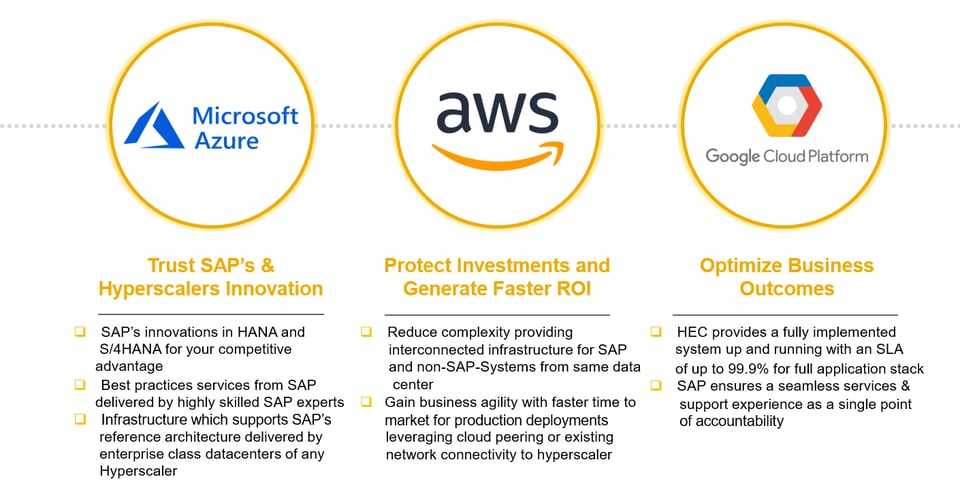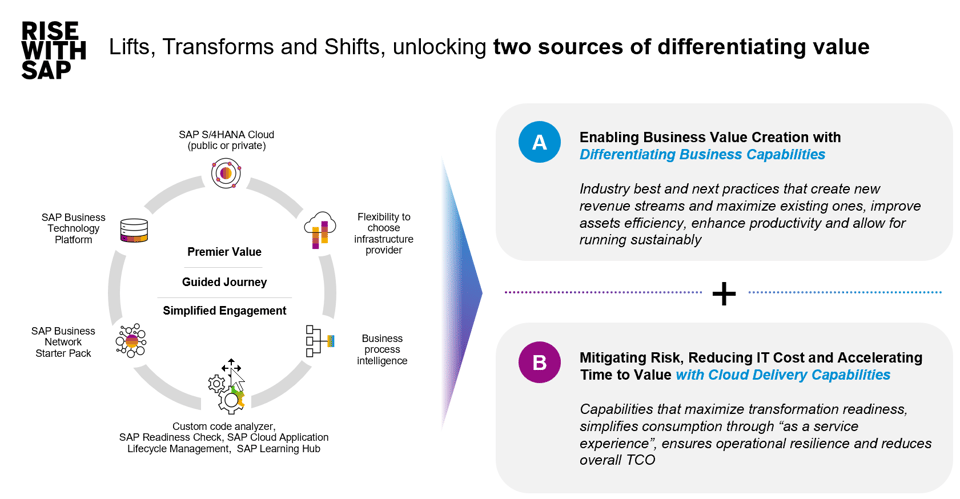How to Manage an SAP Solution in the Public Cloud
As flexibility and scalability continue to be top priorities for large-scale enterprises, the number of companies choosing to run SAP (or other ERP systems) on the public cloud is increasing at a rapid pace. Five years ago, 67% of enterprises were still choosing on-premise ERP solutions. Fast forward to 2022 and that number has totally flipped — 65% are now on the cloud.
SAP has consistently been an innovator and market share leader in the ERP space, as demonstrated by the fact that 85 of the largest 100 companies in the world are SAP S4/HANA users.
Looking to the future, S/4HANA on the public cloud is positioned to provide the highest ROI for SAP organizations that want to reach peak levels of innovation and leadership in their fields. Key to reaching this potential will be effective ongoing management of SAP public cloud solutions.
In the sections that follow, we’ll outline the steps to moving your SAP system to the public cloud, plus three options for SAP public cloud management: in-house, RISE with SAP, and the managed services model.
Quick Takeaways
- Core benefits of operating SAP on the public cloud include cost savings as well as higher agility, scalability, and resiliency.
- Top hyperscalers like AWS, Azure, and Google Cloud each have unique requirements and benefits that must be evaluated by enterprises before they select a provider.
- In-house SAP public cloud management is possible but has limitations related to maintaining best practice standards.
- RISE with SAP is a subscription model offered by SAP to enable a guided journey to cloud transformation.
- Managed services models offer the widest range of knowledge, expertise, and resources for SAP public cloud management.
Why choose to manage SAP in the public cloud?
The need for faster, integrated, agile operations has been long-emerging in modern business, but no more so than the past 2+ years. At the onset of the pandemic, companies adopted remote work models nearly overnight and quickly recognized that they must be able to operate amidst uncertainty without disruption to business as usual.
The public cloud has been a core component of this capability.
Powered by SAP hyperscalers like AWS, Azure, and Google, the public cloud provides companies with a new level of operating agility and has transformed the speed and scale at which they can implement new capabilities, updates, and other infrastructure improvements.

Core benefits of operating on the SAP public cloud include:
- Cost savings - Cloud-powered hyper innovation lowers costs as companies compete to provide new services and bigger instances.
- Agility - Companies have access to more tools and easier deployment on cloud platforms, as well as integration capabilities for creating optimized workflows.
- Efficiency - SAP public cloud users can more easily measure usage and implement better resource allocation.
- Scalability - Limits for maximum size limits of instances and unstructured data storage far exceed the need of even large-scale enterprises on the public cloud.
- Abstraction - Public cloud users can eliminate hardware layers with technologies like containerization and serverless computing.
- Resiliency - Platform services and hybrid cloud models create more resilient infrastructure and effective disaster recovery solutions.
- Security - Through integration, companies can expand security from the public cloud across the entire enterprise landscape.
Read more: Hidden Benefits of an SAP® Public Cloud Solution eBook
Moving your SAP solutions to the public cloud
Choosing your provider
SAP public cloud vendors each have their own requirements around SAP instance types that can be run on their platform (and SAP also controls which ones they’ll support). Top providers also have varied strengths and weaknesses which must be evaluated by the enterprise to determine the best fit for their SAP infrastructure.
LinkedIn offers a helpful multi-part comparison of the “big three” cloud providers complete with SAP-specific analysis.
Cloud migration
Migration is a complex multi-step process. Your solution architecture team must understand the specifics around platform and process requirements of your chosen provider. Then, they must be able to oversee and execute the many moving parts of the actual SAP cloud migration while minimizing downtown and disruption to business operations.
SAP public cloud management
Once you’ve migrated to the SAP public cloud, it requires ongoing management in three primary areas:
- Operations - technical management of applications, security, databases, and overall performance
- Improvement - management of agile business projects in the cloud
- Optimization - taking a data-driven approach to continual cost and performance optimization
Each of these three areas of SAP public cloud management requires a range of technical knowledge, skill, and expertise. To get the highest ROI from SAP systems, companies need a dedicated team with SAP management as their primary focus.
Ideally, SAP public cloud management is supported by a platform tool that centralizes insights, makes them more visible, and contributes to more streamlined management processes.
3 options for managing SAP public cloud solutions
In-house management
Some enterprises have in-house SAP management teams. While this approach can work, it also has limitations, particularly as cloud migration drives faster application development, upgrades, and other changes to SAP infrastructure.
Keeping pace with best practice standards, current technologies, and other key components of SAP public cloud management requires a range of knowledge and resources that aren’t easy to maintain internally. While hiring SAP consultants to supplement in-house teams and provide expert support on specific initiatives, this can be extremely costly, offsetting the financial benefits the cloud can bring to the business.
Rise with SAP
RISE with SAP is a subscription-based solution designed to support enterprises transitioning to SAP S4/HANA and/or the cloud. It bundles licensing, maintenance, and hosting for SAP and provides a guided framework for completing the cloud migration journey. With RISE with SAP, companies can still choose a third-party provider like AWS, Azure, or Google.
SAP itself outlines the value of RISE with SAP as two-pronged: It enables business value creation with differentiating business capabilities and accelerates time to value (among other benefits) with cloud delivery capabilities. However, there are several considerations prior to adopting this approach, as planning ahead will enable a smoother journey.

Read more: RISE with SAP Datasheet
Managed services
The third option for SAP public cloud management is a managed services model. In this model, companies partner with a third-party SAP solutions provider to manage applications, execute improvement projects, leverage data insights, maintain security posture, lower costs, optimize performance and more.
Adopting a managed services model also provides a wider range of insights, expertise, and resources that SAP solution providers gain through their work with many different companies, cloud providers, and SAP itself.
Of note: many companies using a RISE with SAP subscription also leverage managed services to support their transformation efforts, and this is to great benefit given the considerations we linked to earlier.
Transform your SAP public cloud systems with Protera
Protera’s SAP Managed Services include technical management of SAP-related applications, support for agile development projects, and continual performance optimization (including cost reduction and intelligent data insights).
Protera is a Microsoft Preferred Partner for migrating SAP to Azure, as well as an AWS Advanced Consulting Partner with SAP Competency, and the first to migrate SAP in production on public cloud.
Protera Arion is the world’s first operations automation platform designed specifically to optimize SAP-related applications on Microsoft Azure and AWS, and brings thousands of hours of SAP and cloud expertise to your own team.
Schedule a virtual solutioning session to begin your SAP transformation today.